
Content is never free, even if it is stolen (no need to). In any case, you will spend time searching and processing, even just typesetting, and this is already a cost.
We’ll tell you how to organize the production of content for the company so that the costs beat off and it is not painfully painful to pay for articles and not see any return.
Disclaimer: there are no universal solutions, there are few ready-made circuits and they may not suit you, all hypotheses must be checked. But something can be directly taken and done.
Reach all CA groups
Respond at any stage of the user's path
Close needs, engage and sell
Use all available channels
Do not get out of budget
Enterprise Content Ecosystem: Views
And most importantly: linking
Promopult Blog: How We Grew Up
The main thing is blog sales
External sites: not only sell
What content works at different points of contact
Home Content
Guest Content
Content Cost Optimization
Necessary steps to start content marketing
Before you start
Content needs to be produced
All this will be done by people (for money)
Enterprise Content Ecosystem: Goals
- Cover all CA groups.
- Respond at any stage of the user's path.
- Close needs, engage and sell.
- Use all available channels.
- Do not get out of the budget.
And now point by point.
Reach all CA groups
This exercise should be done by the marketer: distinguish the groups of your consumers, combining them according to some criterion - by behavior, by JTBD, by the length of the "life", by the amount of the check, etc.
The guideline should be the usability of the group. It makes no sense, for example, to divide by the amount of the check if the groups differ only in the thickness of the wallet, but you will render them approximately the same services and solve the same tasks. Do not divide into boys / girls if they buy the same thing. It should not be divided into Muscovites and provincials, if they have the same motive for the purchase.
It is necessary to divide so that you see: these are the purple plumbuses on credit, and these are our franchises.
Life hack: it may turn out that several groups with different characteristics will be “covered” with approximately the same content. This is normal.
At Promopult, the picture has developed quite a long time ago and does not raise questions - the guidelines are clear, it’s immediately clear to whom what is needed. Now the column "Targeted Advertising" has been added, but it is very similar to "Contextual Advertising".

Some groups here are cut in more detail, we combined them for a content strategy. But they are used when choosing sites for sowing and publishing.
Respond at any stage of the user's path
Obviously, doing only selling content is an attractive but not enough strategy. The longer the path to the purchase (contract, order), the more diverse the information needs of the future customer. Sometimes you need to start from scratch - just tell that you exist and know how to do something good. Trust, loyalty, assessment of your advantages, removal of objections - it's too early to sell, but the content needs to be done.
How to determine where what content is needed?
A simple rule: the better you know, the more frank you can sell. Going to the mass venue? Bring simple utilities that are needed by almost everyone on this site, complement your capabilities. We went into the professional community - do not retell the alphabet, proceed from the fact that colleagues in the topic, show them an interesting solution to the problem, your solution.
Have you bought accommodation? OK, you can sell, but it’s better to pack the sale again into a solution to some problem.
In their own channels, readers are already loyal to you, they know your product, read your blog and subscribe to your newsletter. So you can unselfishly share knowledge, gently reminding that you are not just, you have discounts on a new tool. Here, guides for using your product will be appropriate, precisely because readers are already in the subject.
Life hack: always proceed from the presumption of awareness. No need to start each article with a definition. “Targeted advertising will help you reach the target consumer in social networks, for example in Odnoklassniki and My world.” That's not necessary. Your reader is already up to date. Start with what he does not know.
Close needs, engage and sell
Obviously. The better you help someone, the more trusting he will be when the time comes to get a wallet. So you need to understand how you can be useful at all, and exploit this knowledge.
In this sense, it is easy for us - we know what worries the two main groups of Central Asia. We can generate enough content, telling how to do something in the field of SEO, SMM, PPC do-it-yourself and inexpensively. Plus, we have free tools that can be offered as a solution to a narrow problem. Whenever we talk about the collection of the semantic core, it’s easy to mention the search hint collector - and now we’ve already got a transition to the system. And there the visitor is already waiting for - banners, widgets, other temptations.
Use all available channels
Again obvious. Sitting upright and waiting for everyone to read our blog is a so-so strategy. They will not come of their own free will. Yes, nobody canceled organic traffic, but it is long and (almost) uncontrollable. Therefore, the strategy should immediately include not only the creation of content, but also the ways of its distribution. More on this below.
Do not get out of budget
Costs need to be considered. It would be nice to learn how to calculate the cost of a lead and compare it with other channels (context, for example). There are areas where the cost of content is practically zero, because other ways to attract customers are effective.
For example, in such a mundane sphere as rental of construction equipment, the context rules, but a blog on the topic of excavator operation will look at least strange. Although it would be possible to propose making a directory of regulatory documents for construction, and this may turn out to be useful (this is only a hypothesis, it must be checked).
But a specialist who offers his services needs to write a lot and a lot of time, and spend time on his own blog and on external sites.
Enterprise Content Ecosystem: Views
As you can see, the list is quite large.
- Internal content (guides, help, directories).
This content also draws on consumer knowledge. It closes the features and problems of using your product, in addition, up-to-date in the texts is relevant. How? Mention related tools, insert native frames, links to other materials.
- Service mailing (trigger letters, etc.).
This content is also internal, but there is one point: you can always add some kind of informational content to any letters. We made a trigger letter “You have not completed setting up the advertising campaign”, add a link to the tuning guide in the tail of the letter - suddenly a person stupidly does not know which buttons to press in the next step.
- Own site (blog external / internal).
It’s obvious here. We are writing about everything that can make a consumer’s life better.
- Own newsletter (content).
This may be a simple digest of articles from the blog - we somehow did a survey of the readers of the newsletter and this format won. And maybe - like our big newsletter - a source of original content for customers.
- Your social networks.
Social networks need to "download." It’s good if you have a strong specialist in targeting, but even better - if you have your own thematic group or someone from the staff often and expertly writes in thematic groups. Reposting a good live group instantly and multiple raises the number of article views. And it's free.
- External “network” (platforms, newsletters, social networks).
Subject of special care. You need to constantly look for information partners, monitor live public on the topic, look for someone to exchange guest articles with or announcements in the newsletter.
Life hack: it’s very important to ensure that the transitions from your articles are targeted. It's a shame if you heat up interest in a new product, and then put a link to the main page, where from this new product another 3-4 clicks. For especially important cases, it’s generally worthwhile to prepare individual boardings.

And most importantly: linking
Everything can be connected with everything. From a newsletter to a blog, from a blog to a product catalog, from an external article to a landing page, and additionally to a blog, and so on. A visitor who has got into your network should see at least two units of content, and even better, go further along the funnel and begin to examine your catalog already.
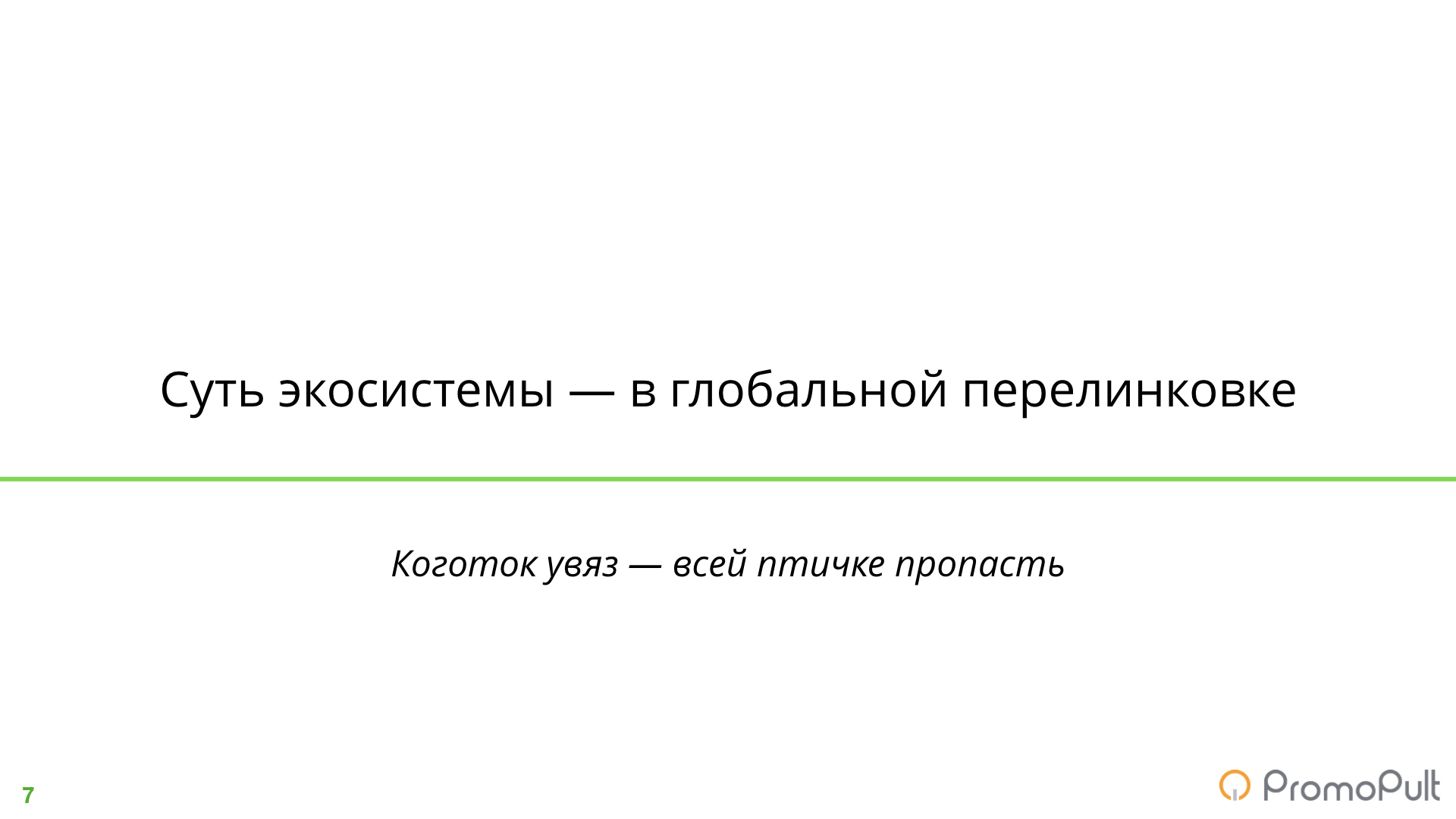
A private example of linking: we wrote quite detailed guides on the use of modules of the Promopult system. They are on the blog, and our technical support sends customers to read these guides when they are asked, "why is this checkbox here." And it brings us popular questions so that we make guides on this topic.

Promopult Blog: How We Grew Up
In detail about how our blog developed, we already wrote . Now let's go through the main points.
In general, the subject matter of the blog and other materials in our country is based on a simple rule: we help our potential clients solve specific, often rather narrow tasks. If they are solved with the help of our tools and system modules - excellent, if not - we will write an article anyway, we simply make up an advertisement for the service in it.
Once we asked readers what they want to see on the blog, and here's what happened:
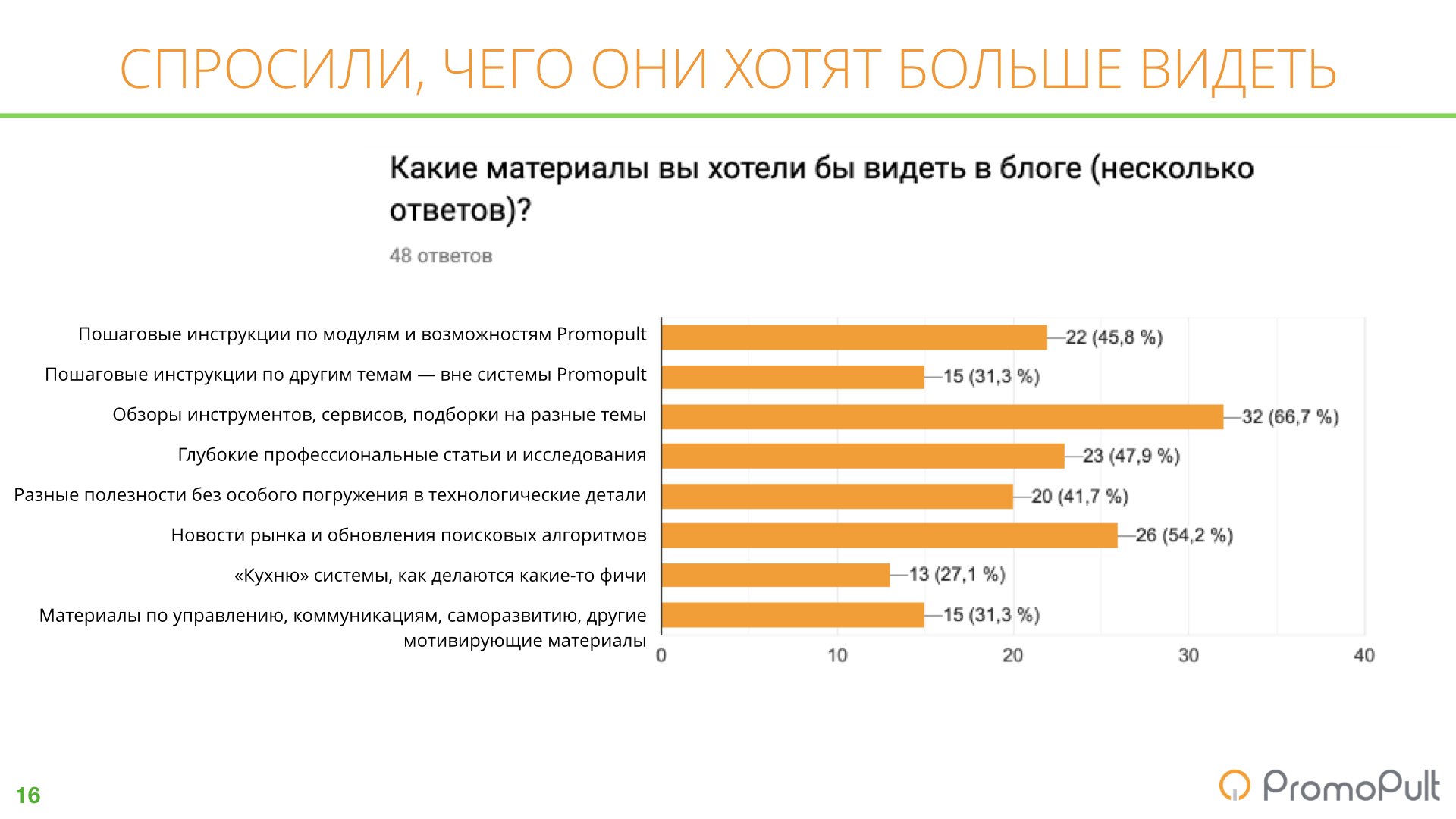
Our statistics confirm this, the most popular articles on the blog are reviews of various services, from Snapseed to Screaming Frog .
From the very beginning, we put a lot of effort into optimizing the content on the blog, as well as updating the popular content.
This is what you need to do all the time, especially if you have a solid array of texts. If this is good content, it must be updated, if you have inherited a set of articles, you need to sort them by popularity and systematically rewrite them with keys.
This work has given us good results:
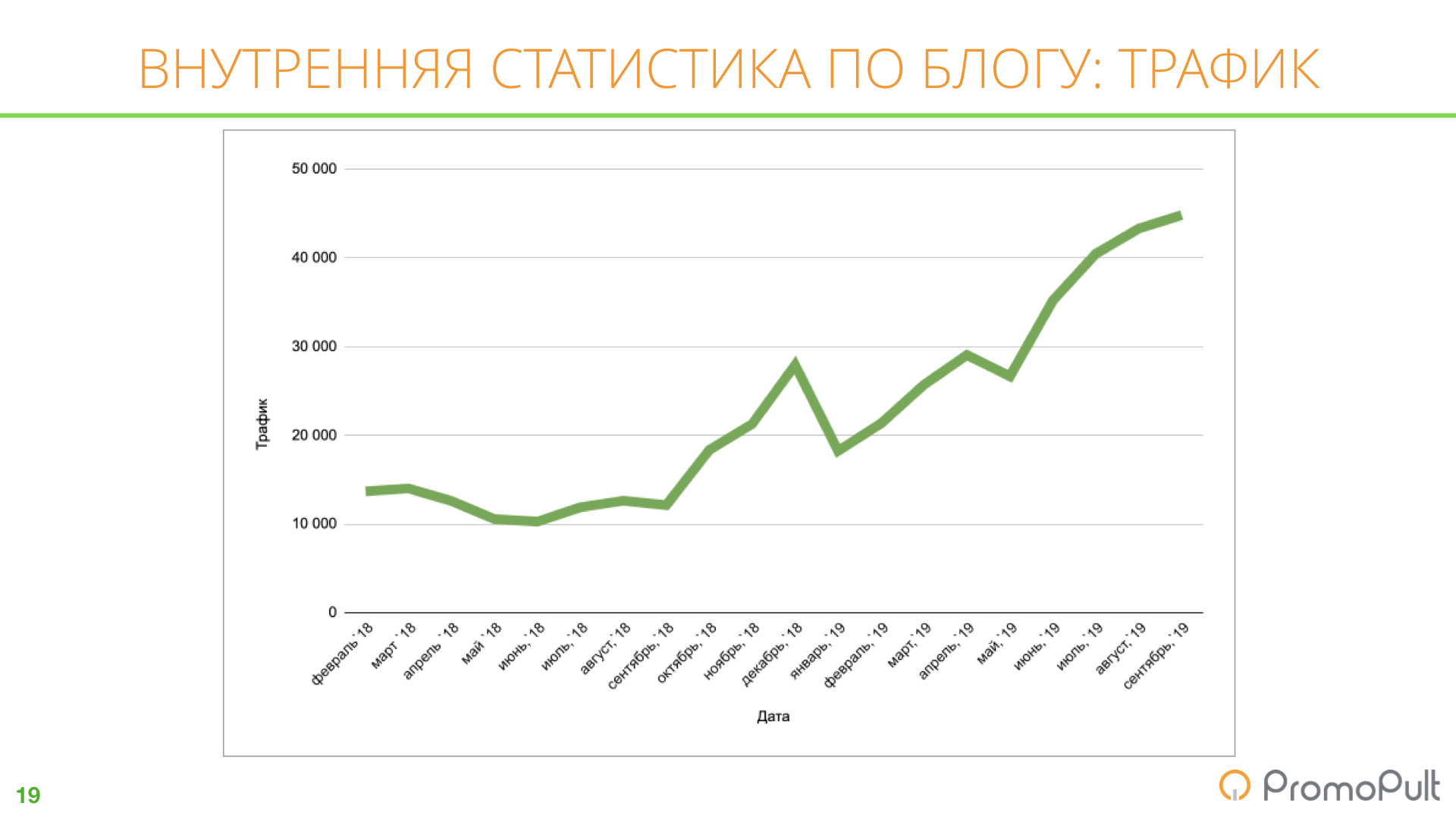
The main thing is blog sales
Well, why else should a company blog? Attract, warm, sell.
We sell mainly through native inserts - they contain a link to a module or system tool. An article can be quite far from our specific tools, for example, about contests on Instagram or about zero-click issuance , to enter here organically a mention of our service is difficult. A native insert looks honest, not too intrusive, and does not force to break the logic of presentation.

The result of such "gentle" manipulations is transitions to the system and registration.
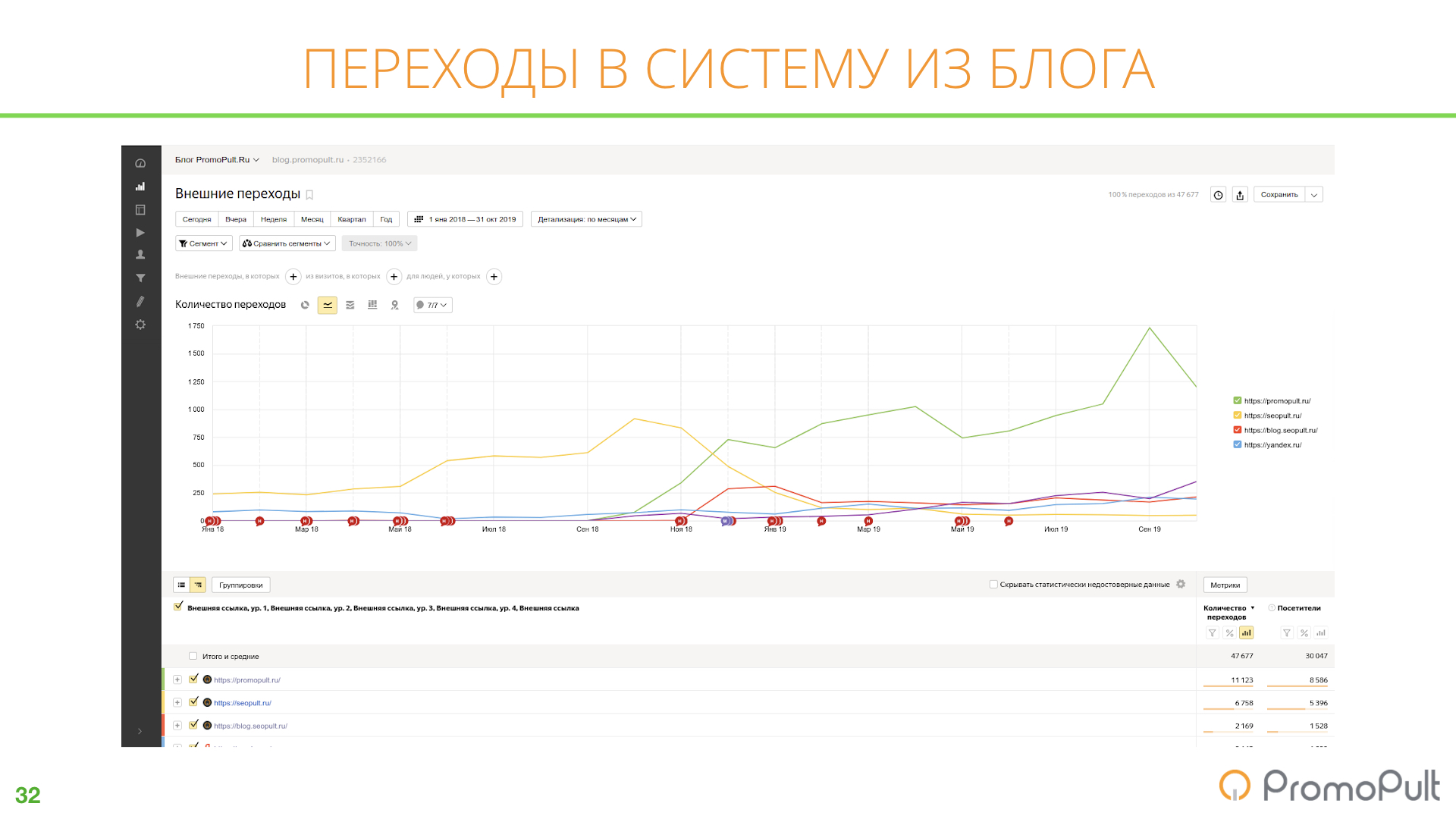
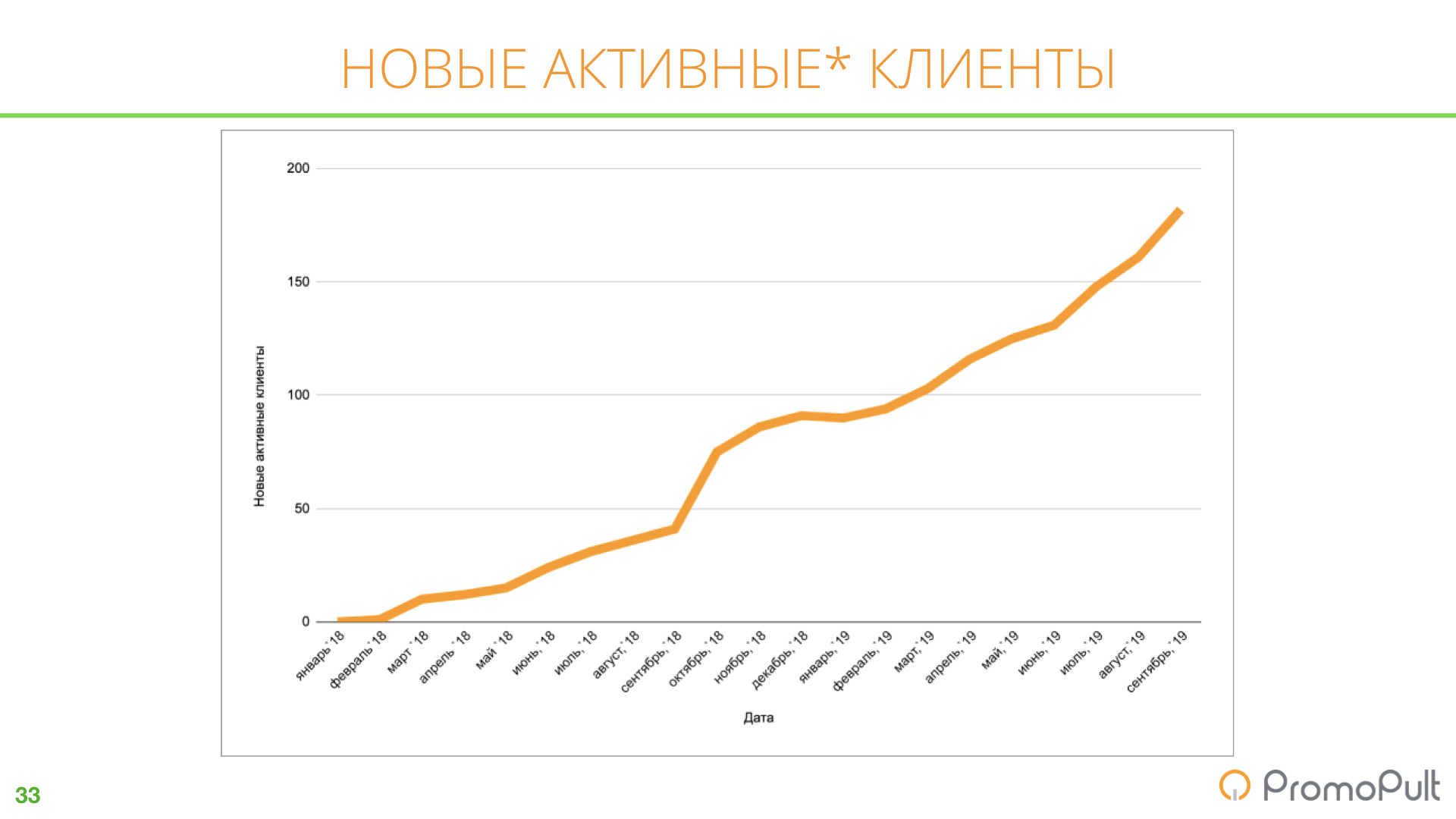
Active are considered customers who have replenished their balance and perform some actions in the system.
PromoPult system is an advertising complex for attracting customers from the Internet. SEO, PPC, SMM in one account. Full automation, ready checklists, precise settings. One-click customer reports, result guarantees, industry solutions. Designed for those who want to free up time for really serious work.
External sites: not only sell
External platforms - mass media, thematic portals and websites, small thematic expert blogs, content platforms - places where your potential customers are “found”. The wider the theme of the site, the less likely that they know about you there, this must be taken into account.
Here you shouldn’t sell directly on the forehead, the audience is not warmed up enough for this. But you can build awareness, demonstrate expertise, attract to your ecosystem.
A good format is an external blog or column in the thematic media. For example, we conduct several such blogs at once: on vc.ru, cossa.ru, habr.com, seonews.ru will be added soon.
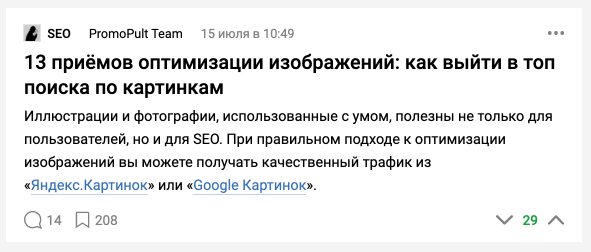
Life hack: don't underestimate content projects and small blogs. These are sites that are most often made purely for the sale of traffic, they do not have the solidity of serious portals. But the traffic there is quite themed, and the placement price is ridiculous. If you have a wide enough audience, content projects can be a good way to reach it.
Our ongoing publication plan includes several sites.
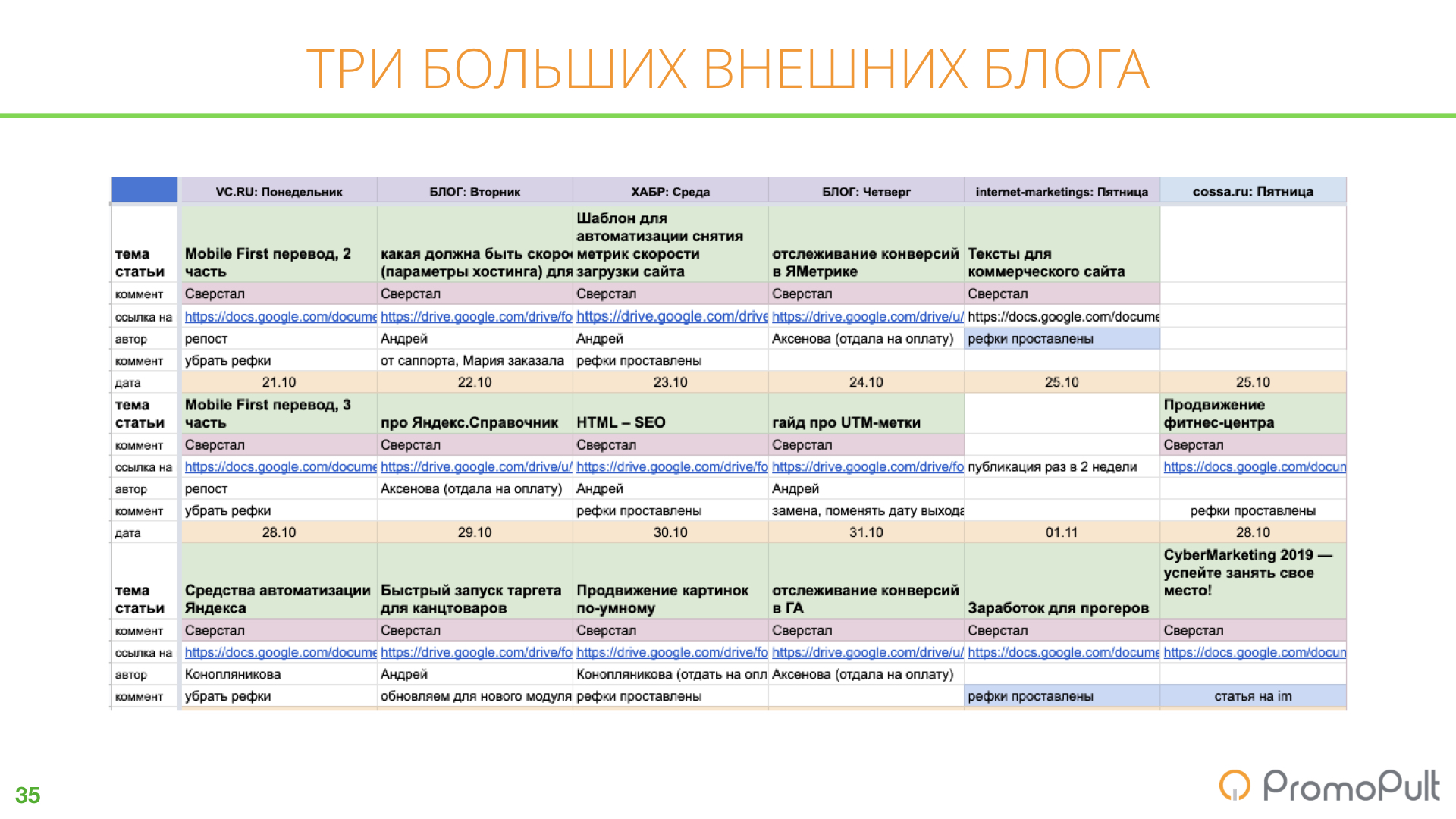
As a result, we get both audience coverage and direct transitions to the system.
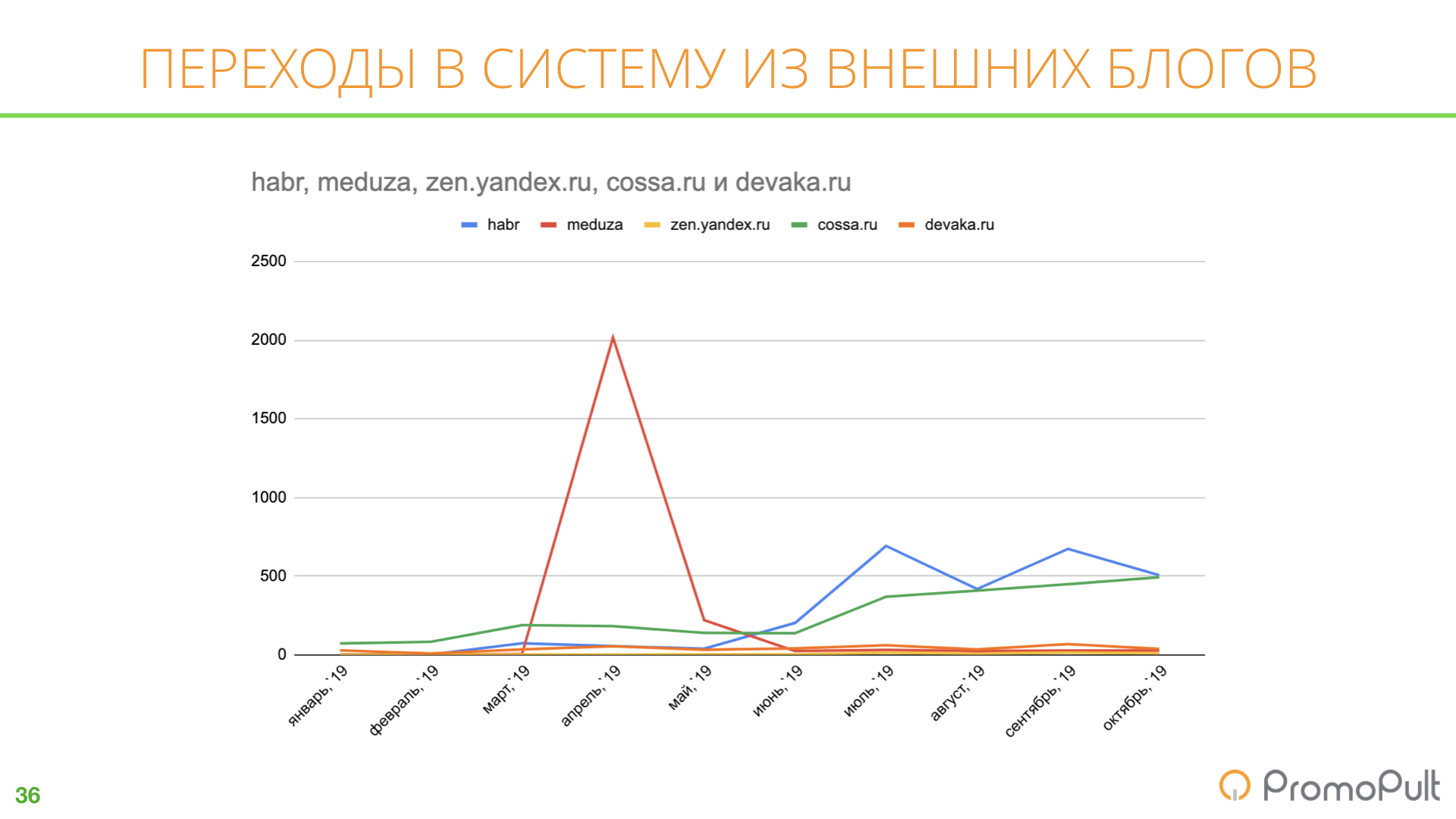
About how and what to carry in the editorial office so that the article is accurately taken (video).
What content works at different points of contact
The main criterion for choosing a theme and format is the relevance of the content on the site. At your own site, you are more free, visiting should be more modest, more accurate and more useful.
Home Content
Evergreen, educational, honestly advertising content is good for its site. You are here for a long time, visitors should get used to getting useful information from your hands. Therefore, it is worthwhile to draw up a detailed content plan, considering the key need of your client from all sides.
- Answers to frequently asked questions.
First, do not invent these questions. Go to your technical support, to account managers, to everyone who encounters customers. Get a list of burning questions and sore spots. And write a FAQ. If you do not ask anyone, read the thematic forums, spy on competitors.
Important: these are questions not only about your product, but also around it. For example, to questions about setting up the Landing Designer, it’s quite possible to add a block of legal questions (do I need a license to work), a large topic of processing illustrations, a simple guide to usability.
- Guides on the tools (their own and others).
This type of content has been repeatedly mentioned above. It is amazing how much simple step-by-step guides are in demand. To show “which buttons to press” and describe some of the most usable scenarios of work in the service - hundreds of readers will be grateful to you.
- Service news and industry news.
It is obvious.
Life hack: any announcements of updates can be packaged in subject instructions. Not “We released a new feature, it does this and that”, but “How to solve this applied problem using our new feature, which can do this and that.” Example: How to quickly launch targeted advertising for seasonal goods [instructions] .
- Learning the basics and subtleties.
Even if you will tell how to do with your own hands what you take the money for yourself, it will be appropriate. Most often, an attempt to do something with your own hands or even just looking at the instructions already leads to the understanding that everything is somehow very difficult. And it’s better to order it all from professionals.
It is also important to consider the so-called Climber's case . Imagine that you started walking in the mountains. They mastered the surroundings, went to the Alps, climbed onto some wildly difficult peak. Go down, and you are asked to tell how to correctly calculate the strength when climbing the hills.
- Pffff, what kind of questions, let's better talk about spending the night on a steep rock ...
- No, no, about the hills, please.
Because it’s you who in your development now reached the rarefied air of the mountain peaks. And those who came to the conference read your blog, and most importantly, will buy your product - they are still down here. Conquer the hilly surroundings.
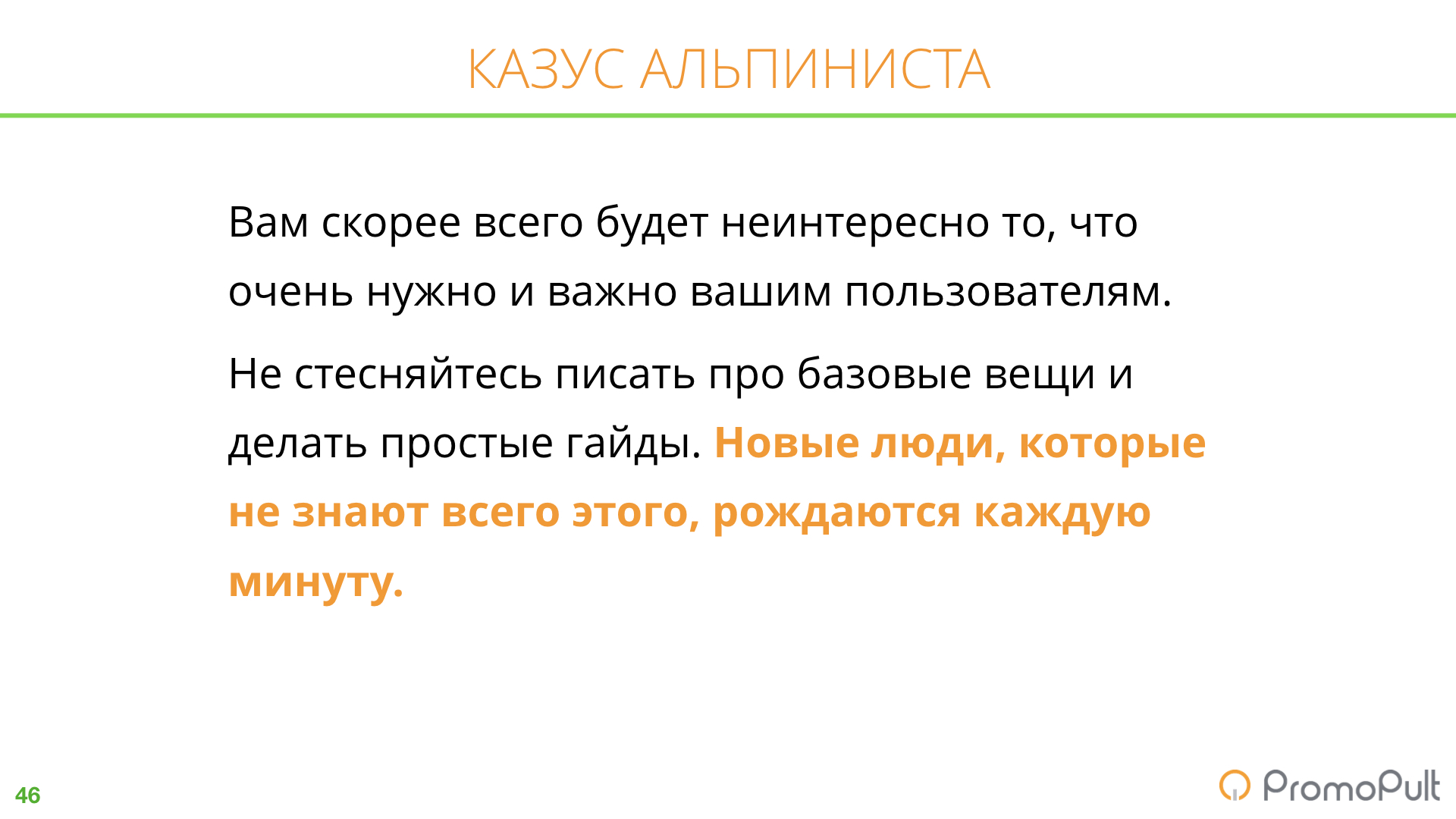
- Cases and success stories (customers).
Own platform is the most suitable place for cases. They will even be searched here when they begin to study your proposal. Therefore, here you can make cases "It was / became" with customer reviews, statistics and other evident beauty.
In fact, cases need to be packaged more carefully. On a third-party site, few people are interested in how bad your client was before, and how good you were. External cases need to be made more like guides. “That was such a problem, that’s how we solved it, that’s how you can apply our experience (or hire us, of course).”
Guest Content
Strong texts should be carried to someone else’s site. “In a dressing gown and slippers” you can only go to a narrow professional platform where you have long been known and highly regarded as an expert. In all other cases, you will have to not only prove that your text is worth reading, but also compete with other texts.
The exception is micro-blogs and content projects, which we talked about above. It is enough to write texts of a normal level, not trying to do something outstanding.
What you can write about on external sites:
- Answers to frequently asked questions.
The same questions from the FAQ can be dealt with in articles. Of course, you need to choose the most pressing and demanded questions. And answer them in detail.
- A selection of utilities (including your link).
We have already talked about the popularity of collections. Everyone loves collections, including editors - especially if you add materials from this site to the collection.
- Situational content: what happened and what to do in this case.
If you can catch trends, you need to do it. For example, last year Yandex introduced a new pusomerka IKS instead of TIC. We first wrote “The History of the TCI ”, and then our experts conducted several experiments and already issued ICS analytics .
- Well-designed promotional materials (benefit plus benefit).
Naturally, sometimes you can and should just sell. If you are buying accommodation on a fairly expensive site, make sure to pack your offer with the utmost quality.
- Well thought out benefits for site visitors. It can be entertaining material, as, for example, our cards on Medusa: “We translate from Russian into Russian” . Obviously, it’s pointless to publish serious SEO recommendations on a mass portal.
- A neat bundle of your product with the topic of the article.
- A strong landing page that will receive traffic from the article.
And it’s not always necessary to set a sales goal. The image of the company needs your support, your HR brand, the product itself needs to be popularized by all means.
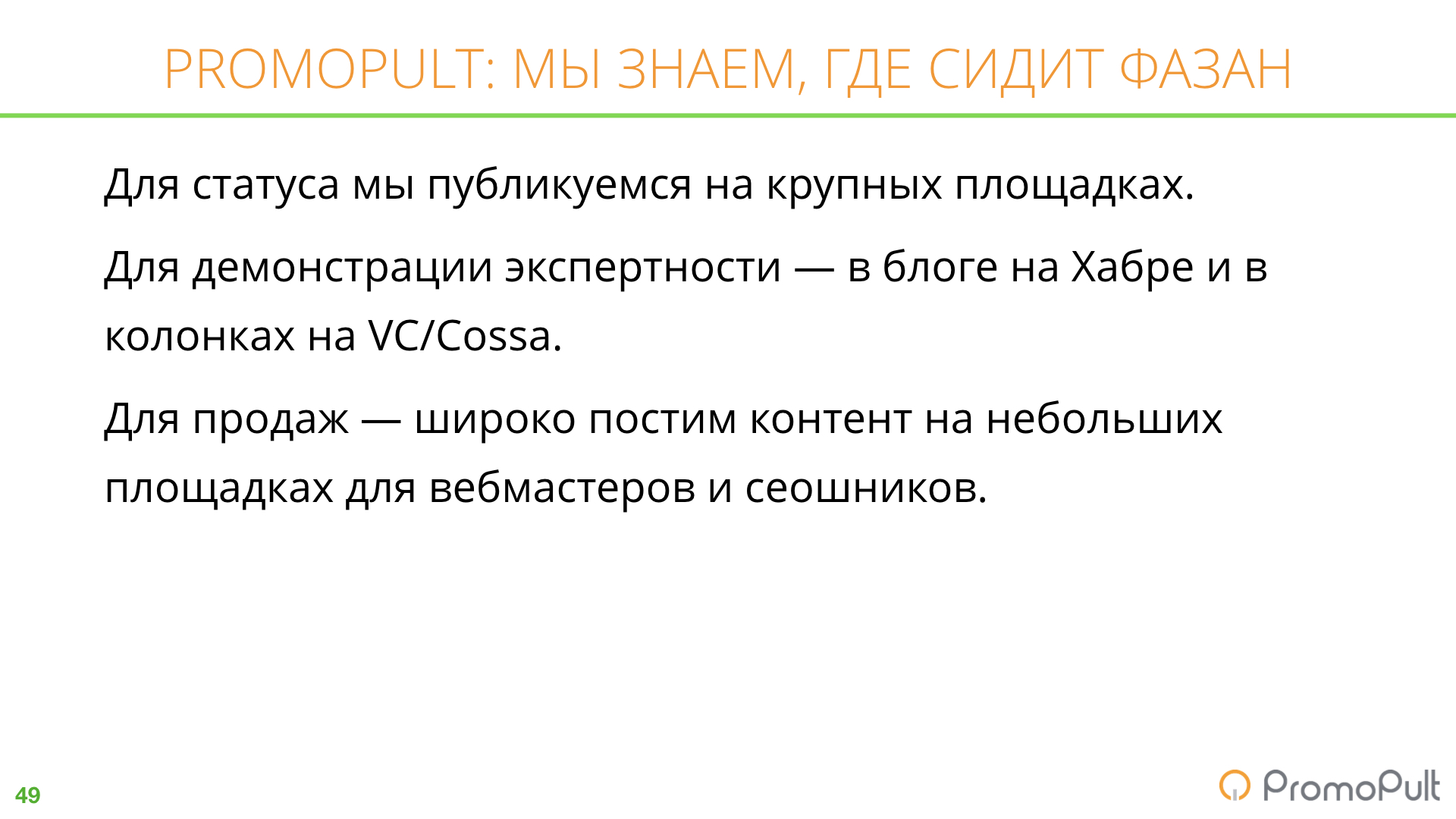
Content Cost Optimization
To not be painfully painful to write off the cost of content, it is worthwhile to dispose of it wisely. For example, to use the "fired" material more than once.
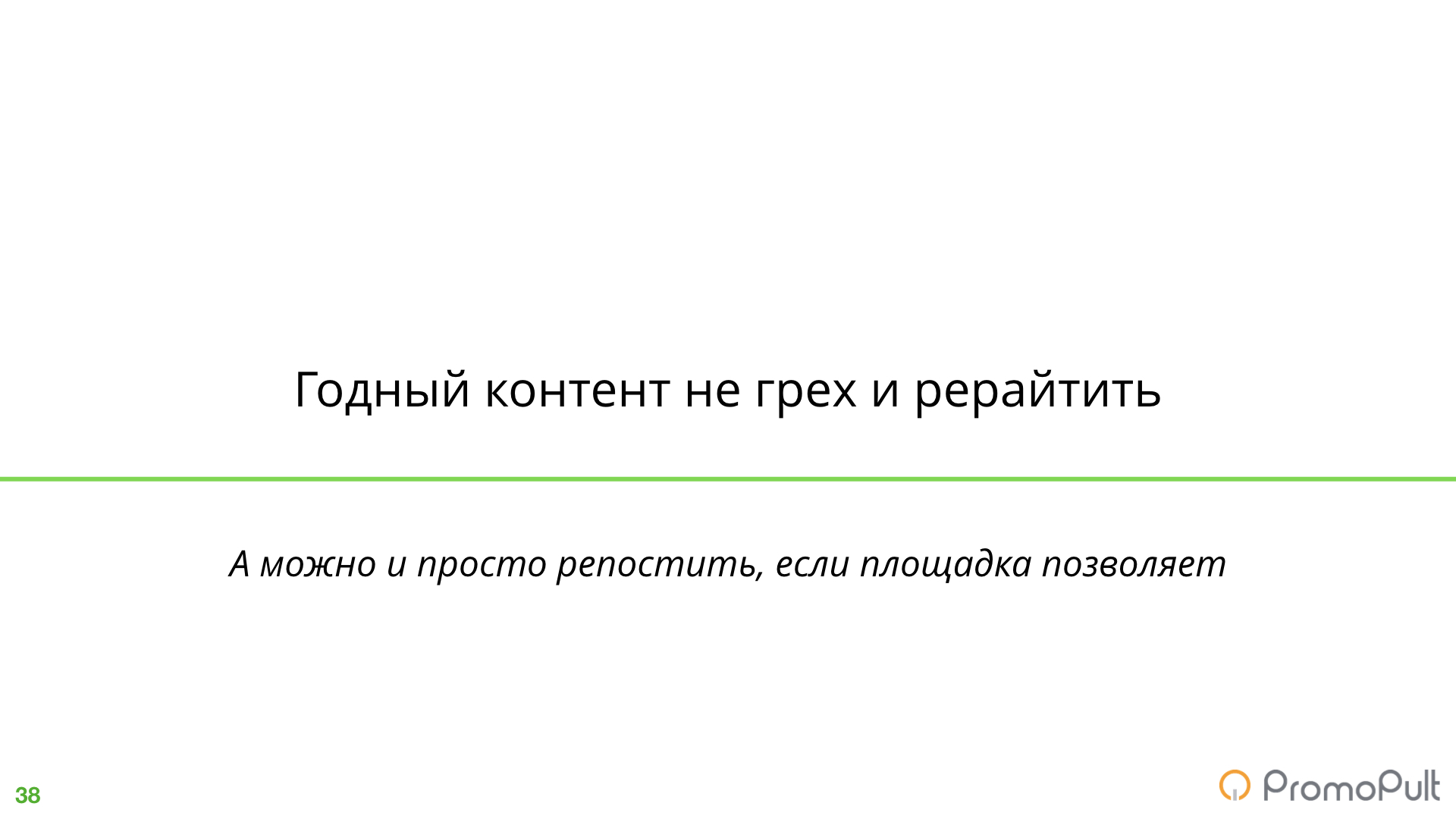
You should not follow up with SEOs fluttering about the uniqueness of content. Yes, sometimes the first publication ceases to be considered the primary source, but that's it - your content. In any material there will be a link to products, any material works for you. If the site allows - you can repost.
You can repack almost everything. Any unit of content can be processed and served in a different format. Once your expert has created something useful, as soon as you see that the article has caused a lot of comments and reposts - you need to look for ways to use the content again.
- Wrote a great guide? Do a lot of small instructions (and vice versa).
A large guide will go to the blog, small instructions - to internal content, to the term library, to user tips. Sometimes a large guide can be divided into two or three materials. For example, we wrote about contextual advertising in Yandex and Google, then we disassembled it into parts and slightly supplemented, two materials came out - about Yandex.Direct and about Google Ads.
- Once every six months, collect a thematic selection of articles.
Collections - TOP-1 by sher. This is inexplicable, but any post with a collection collects many times more sharing than anything else. In addition, making selections is less time-consuming than regular materials, since you do not need to create a coherent, well-developed text, just think up a topic, collect links and write short links.
Important: do not make collections without a topic. “10 popular articles of our blog for half a year” - so-so idea. But “ 50+ guides: how to attract customers to the online store ” - normally falls into the interests of blog readers.
- Passed a webinar - make an article (and vice versa).
Most webinars are pretty good in terms of content. Material is collected, illustrations are prepared, there is a record. If the speaker is not very good at texts, you can decrypt the record, the editor will process it, and then the speaker will review and correct the details. An expert article is ready.
In the opposite direction, this also works - if there is a good article, you can use it to create a webinar for clients.
- The conference has passed - make a lot of articles.
Exactly the same way you can handle the presentation at the conference. And if you conduct events yourself - make materials on the speeches of all speakers. They will be grateful for the preparation of materials and publication, and you will receive good materials on the blog.
- Made a good guide - record a video (and vice versa).
Good guides should not be dead weight. If you have a video channel, the guides will be an excellent material for recording training videos. And again - in the opposite direction it works no worse. For example, if an expert did a screencast on setting up a tool, it’s easy to decrypt the record and make a guide on this setting.
Necessary steps to start content marketing
Below we summarize the experience with content in the edition of Promopult.
Before you start
It is necessary to clarify some points that may affect the setting of goals and decision-making when developing a content strategy.
The difference between the usual routine of working with content from content marketing is for purposes. One way or another, content is produced by any company. The fun begins when you think about how this content pays off and how to make it work better. Before investing in content, it’s worthwhile to understand what place content marketing will take in your strategy.
- You are already using channels to quickly attract traffic / customers.
Selling articles are fired once, articles on the blog do not give explosive growth in leads, external expert publications can attract traffic, but not the fact that they will sell. It’s better to engage in content already when you have learned how to get enough customers in other ways.
- You do not expect to make KM the only sales channel.
See above. Yes, there are areas where content is the main driver of sales. But the bulk of it is still integrated marketing.
- You understand that this is not free or even cheap.
There is simply no free content. A cheap article can increase its value by several times when it is re-read three times and rewritten by the staff editor.
There are strategies that cheap texts fit into, but usually there should be a lot of them. So pennies are multiplied by tens and hundreds - and turn into the same thousand rubles.
- You realize that the story will drag on for more than six months.
Yes, this is the slogan “Content marketing is a long game”, which has already been imposed on our teeth. Even blog indexing takes at least three months. As in other areas, some time and money will have to be spent on tests. Some articles written by strong experts and posted for a fee will go “into milk”. Understanding how to do well, and regularly with the expected effect, does not come immediately. All of this is worth laying a certain budget.
- You are ready to devote time to work with content.
Surprise: this factory will not work without you. Even if you find a strong editorial staff and outsource all content marketing, they will still come to you regularly. For expertise, fact checking, check benchmarks, find new questions and pains of clients, just talk.
OK, you are ready and agree. Let’s then see what and how to do with the content.
Content needs to be produced
- prepare: collect information, interview experts,
- create: write and edit text, prepare illustrations,
- layout on the site,
- promote in social networks, newsletter, targeting and context,
- post materials on third-party sites,
- analyze the results.
All this will be done by people (for money)
- cook: author or editor,
- create: author, editor, content manager,
- layout: layout / content manager,
- promote: smsmshchik, traffic-specific, marketer,
- post: PR / marketer / content manager,
- analyze: marketer, analyst.
As you can see, as a result, you will have in your payroll not only an editor and a couple of deleted copywriters.
The good news is that some positions can be combined. For example, in Lifehacker, the authors themselves impose their articles. Sometimes authors themselves select illustrations. You can have a writing editor and he can do content analytics. You can download the layout of your full-time typesetter’s blog and use a designer to prepare illustrations.
But in general, as you can see, the implementation of the content strategy will require your complicity, considerable investments and long efforts.
In order to calculate what the work with content will result in, you can paint this list (prepare / create / make-up) in the form of a table. And opposite each action, affix the contractor and the estimated costs. If the work will be done by a full-time specialist, you can roughly estimate the hours of work and their cost.
So you will see what resources are required.
Life hack: it’s worth doing all these calculations with an already hired editor. The editor is better acquainted with all these processes; he may offer some ways to reduce the cost of production or redistribute funds to more priority work.
In the same way - with the editor - it’s worth compiling a content plan and choosing the channels that you will use in the first place. You can do it yourself, but then you still have to rethink the strategy based on what your editor is digging up.
As a result, everything works. It costs money, it happens that it does not work, it requires patience and the ability to negotiate. But it works.
The article was prepared on the basis of the report of Katerina Eroshina at the CyberMarketing-2019 conference.